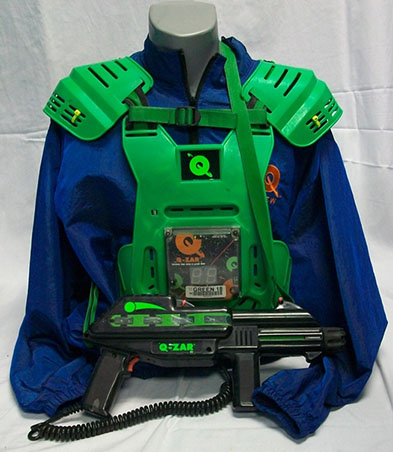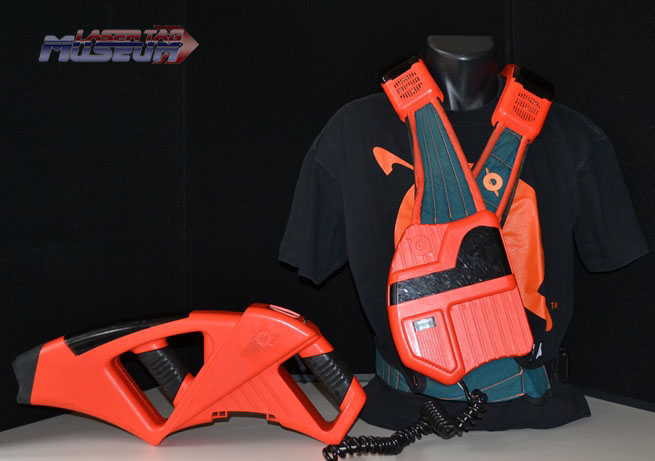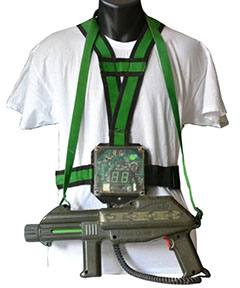Q-Zar











Founded By: Geoff Haselhurst
Originated: March 1, 1987
Personnel of Note:
Geoff Haselhurst – Founder
Peter Robertson – Co-founder
David Cox – Ex – Owner credited with bringing Q-Zar to the UK
Omnitronics (Perth, WA) – Contract manufacturer of the hardware and software
David Nicholson – Managing Director
Peter Lowe – Director
Jim Wilcox – Director
Nathan Buzza – Software Engineer
Kevin Davies – Electronics Engineer
Alan Parker – Commercial Director
Nigel Broadfoot – Procurement
Quasar Limited (UK) (Defunct)
Ivano Cafallo – Director
Brian Murphy – Director
Michael Boyle – Director
Colum Butler – Director
Thomas Butler – Director
Joseph Creighton – Director
David Cox – Ex-Owner of the Quasar rights for the UK.
John Kavanagh – Secretary
Q-Zar Franchising Inc. (USA) (Defunct)
Thomas Butler – President and Chief Executive Officer
John Cooke – Executive Vice President and Chief Operating Officer
Charles Gavin Sayers – Senior Vice President of Business Development
Neil J. Farren – Senior Vice President of Sales
Jim Found– Vice President of Operations
Robert Delvecchio – Vice President of Sales
Darren Burke – Research & Development Manager
Joe McIntyre – Project Manager
Q-Zar Systems (USA) (Active)
Sean Evans – President
Trisha Pereira – Vice President
First Location: The Quasar Centre, 160 Beaufort Street, Northbridge, WA, Australia
Equipment Overview: Q-Zar has gone through several generations of equipment known as “marks” since originating as Quasar in 1987. Over the course of ten years, five generations of marks were introduced by Q-Zar.
Mark 1 was the first version of Q-Zar which was manufactured between 1987-1988, featuring a six-inch electronics box on the front with a smaller (approximately 2×6 inch) battery box on the back, attached to a harness. This version included a one-handed phase that featured a clear barrel.
Mark II had a similar harness as the earlier version with a newly designed two-handed phaser style made of a rubberized-style of material. This version was produced between 1989 and 1992.
Mark III was the first version to introduce the familiar BMX “body armor” styling and a shinier hard plastic was used for the two-handed phaser. Both the Mark III and Mark IIIB were first introduced in September of 1992 with the next update including a custom BMX-style plastic armor, slightly modified phaser shell and updated electronics between late 1993 and 1995.
Mark V is perhaps the best-known version of Q-Zar, which debuted in 1995 with brightly colored fluorescent green and orange plastics for the body armor accompanied by a phaser similar to the previous version.
What would have been Mark VI was never introduced by Q-Zar, but did come to be in a different way. Another company, Heads-Up Technoloy, ended up selling the equipment under the name “LaserTrek”.
Mark VII was better known as iQ and is a rarity in the history of Q-Zar in that it was never introduced as a fully functional system. Only 18 iQ units were ever known to have been made and we are fortunate to have this version represented in the collection with thanks to Sean Evans and Trish Pereira of Q-Zar Systems who donated two in packs in February of 2014.
Q-Zar did create other styles of packs for specialty markets including the following:
MegaQuest featured a harness along with a dark-olive colored two-handed phaser. The equipment was attached to a harness, much like the first generations of Mark I and Mark II and was intended to be a less expensive laser tag option.
Q-Tag was created as an option for children under 12 and featured a blue or yellow sash along with a matching color phaser, a bit smaller than the standard phaser size.
Historical Overview: The following history is quoted as previously compiled with care by the former Laser Tag Museum curator who gave tremendous time and dedication to the research of the Q-Zar history.
* There are an enormous amount of business entities associated with Quasar/Q-Zar and we have done our best to research and document as many as possible. There may, however, be some that we have missed. If so, please contact us via the Laser Tag Museum Collection website at lasertagmuseumcontact@gmail.com.
“In March 1987, Geoff Haselhurst comes up with the idea to develop a laser tag system later known as Quasar in Perth Australia and opens his first site on June 1, 1987.
The original software for Quasar was created by Nathan Buzza who was just 17 years old at that time. Nathan’s talent did not stop at the software as he also created the original logo for Quasar. He also wrote the enormously popular video game “Q*Bert”. Later, as an adult, Nathan would become an award winning technology pioneer and company director at AlcidionCorporation.
David Cox, a school teacher at the time, visits Australia and plays Quasar. He then proceeds to buy the UK rights from Geoff in December of 1987 and brings the product to the UK. He opens Quasar in Haringey, London, UK.
On March 31, 1988 Quasar Limited is incorporated in the UK under company director Ivano Cafolla of LeisureCorp.
In 1989 after visiting a Quasar site in the UK, the Irish businessmen under the company name LeisureCorp saw the potential of the system and bought the rights from Mr. Cox.
In 1992 a North American subsidiary of Quasar Limited is incorporated in Dallas, TX and the company name is changed from Quasar to Q-Zar.
In approximately 1992, the name of the laser game product changes from “Quasar” to “Q-Zar”. The creator of the name “Q-Zar” was the marketing firm “The Leisure Process”. Mr. John Carver, from the marketing firm also developed the marketing copy line “Serious Fun with a Laser Gun”. Mr. Carver now has his own marketing firm, Cunning.
Mr. Carver personally wrote and created many of the “in your face” marketing pieces that became iconic to the Q-Zar brand. The marketing helped propel Q-Zar and the rest of the laser tag industry into the lexicon of cultural acceptance.
The product name change from Quasar to Q-Zar was due to a trade mark conflict with Phillips Magnavox’s brand of electronics called “Quasar”. Q-Zar was selected since it sounded similar but would not create any brand confusion.
In December of 1993 Q-Zar Holdings Limited (“Q-Zar Bermuda”), a company under the laws of Bermuda by management of QUSA, is acquired in an arm’s length transaction. 95.8% of the issued and outstanding shares in QUSA and the exclusive intellectual property rights of the Q-Zar game for North America, South America and the Pacific Rim from Leisure Corp Limited. Q-Zar Inc. subsequently acquired the minority shareholding in QUSA.
On July 1, 1994 Q-Europe is incorporated in Dublin Ireland with John Cooke, John Michael Boyle, Charles Gavin Sayers and Thomas Butler as company directors.
On November 15, 1994Q-Zar Limited is incorporated in the UK under the same Director as Quasar Limited, Ivano Cafallo.
On February 21, 1995 a meeting of creditors is posted in the London Gazette beginning the dissolution process of Quasar Limited.
May 1995, Q-Zar Inc. and Q-Zar Canada are incorporated in connection with the reorganization of Q-Zar Bermuda.
August 1995, through the Q-Zar Inc. subsidiary Q-Europe Limited, Q-Zar Inc. purchases all of the outstanding shares of the companies comprising the QML Group. Q-Entertainment owns the worldwide intellectual property rights to substantially all Q-Zar products.
In 1995 Quasar England closes down; all European support is directed to Quasar Ireland. Later that year Quasar Ireland is renamed to Q-Zar International and is significantly scaled down.
January 1996, Q-Zar Inc. acquires all of the issued and outstanding common shares of Entertainment Technologies Inc.
In March 1997, Q-City is opened in Mesquite TX. It closed in December 1997.
On June 24, 1997 a dissolution notice is posted in the London Gazette for Q-Zar Limited.
On December 29, 1997 Q-Entertainment filed for Chapter 7 Bankruptcy.
On July 6, 1998 a hearing is set by the Bankruptcy Court in Dallas, Texas regarding the business entities of Q-Entertainment Inc., Terrier Holdings Inc., Entertainment Tech Inc., Q-West LLC., Q-Networks Inc., and Q-Zar Northwest.
In 1999, the bankruptcy proceedings against Q-Zar are closed. Mr. William Low of San Francisco purchased the assets of Q-Zar from the bankruptcy court.
In 2002, Q-Zar Systems of Concord, CA was formed to purchase the assets and rights from Mr. William Low. Since then, Sean Evans and Trisha Pereira, have continued to promote, develop and assist in ensuring the Q-Zar brand stayed active in the industry.
On June 13, 2005, JR Robels sold 49% interest of Q-Zar USA to Summit Entertainment Group, headed up by Mr. John Jarvis.
Q-Zar continues to be serviced and supported throughout the USA and Europe to this day.”
